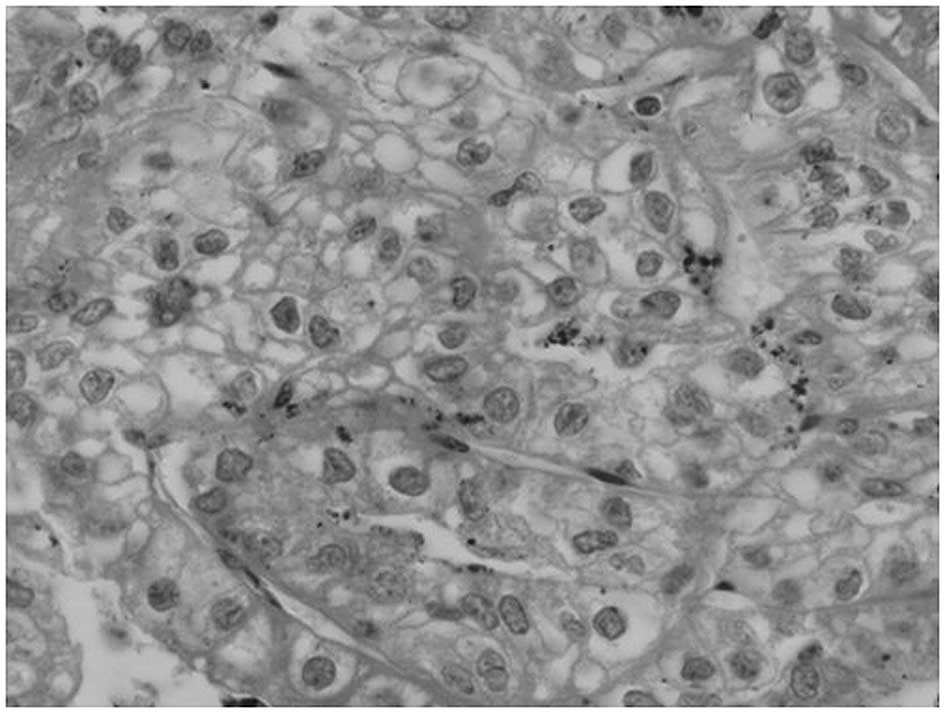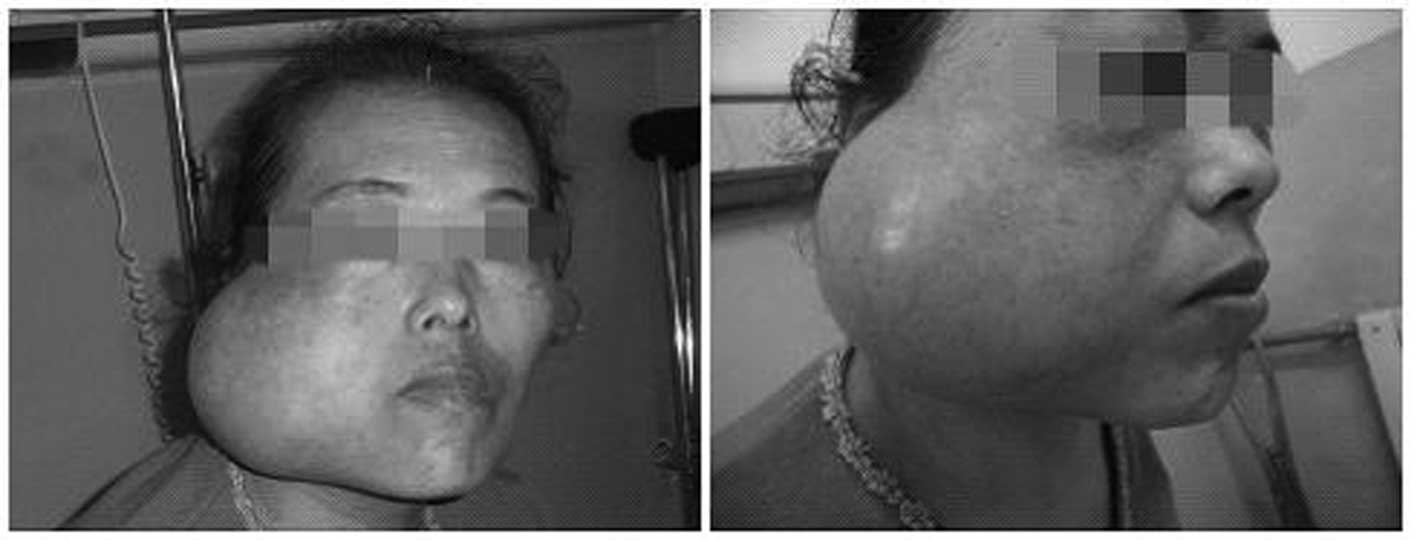Metastasis to the parotid region as an initial presentation of renal cell carcinoma: A case report
- Authors:
- Published online on: January 7, 2013 https://doi.org/10.3892/ol.2013.1110
- Pages: 997-999
Abstract
Introduction
Metastases of malignancies to the parotid region are relatively infrequent (21–42% of all malignant tumors) and originate primarily from head and neck squamous cell carcinoma and melanoma of the skin (1). Metastases of an infraclavicular origin are rare (0.16–4%) (1,2).
Renal cell carcinoma (RCC) is known for its high propensity for early metastasis and ≤1/3 of patients diagnosed with RCC present with metastatic disease at the time of diagnosis (3). Although RCC may metastasize to any organ system, its metastasis to the maxillofacial area is a relatively rare phenomenon. This study describes a patient whose first clinical presentation of RCC was parotid region metastasis. To the best of our knowledge, this case is the first documented example of such large metastasis of RCC.
The study was approved by the Ethics Committee of The First Affiliated Hospital of Medical College of Xi’an Jiaotong University, Shaan’xi, Xi’an, China, and written informed consent was obtained from the patient.
Case report
A 44-year-old female visited our hospital due to the presence of a painless mass in her parotid region. The patient denied all genitourinary symptoms and was otherwise well. Laboratory studies revealed normal hemogram, urinalysis and blood ureanitrogen results. The results of a complete ear, nose and throat examination were also normal. The head and neck computed tomography (CT) scan revealed a 4×2.5-cm mass in the right parotid region accompanied by an osteolytic destruction of the right mandibular branch (Fig. 1A). A roentgenogram of the chest was observed to be normal. Further examination by an abdominal CT scan revealed a 6.5-cm mass in the left kidney, suggesting RCC (Fig. 2), and a mass in the right iliac area accompanied by a slightly osteolytic destruction of the right iliac bone (Fig. 3A). A radical nephrectomy was performed. The histological analysis revealed a renal clear cell carcinoma (Fig. 4) and confirmed the renal tumor to be the primary neoplasm. The patient was then discharged from the hospital, as she did not accept any further treatment.
After seven months, the patient presented with the mass in the right parotid region that had enlarged to a ball-like size and was causing a difficulty in opening the mouth. On physical examination, positive findings consisted of a firm mass measuring ∼12×13 cm in the parotid region (Fig. 5). The mass demonstrated no tenderness but had local heat. The CT scan revealed that the masses in the right parotid region and the right iliac area had enlarged to 12.5 and 13.5 cm, respectively, and were accompanied by serious osteolytic destruction of the right mandibular branch and the right iliac bone, respectively (Figs. 1B and 3B). Furthermore, liver metastasis, multiple bone metastases and bilateral multiple metastatic lesions in the lungs were identified. The patient was administered interleukin (IL)-2 and bisphosphonates, and received local radiotherapy to the right parotid region and pelvic cavity. However, after three weeks, oral mucositis occurred. Due to unbearable pain, the patient did not accept further radiotherapy. Therefore, targeted therapy with sunitinib was recommended; however, the patient refused this treatment due to its high cost. The patient was treated with Chinese medicine and supportive care. Further follow-up continues.
Discussion
In adults, RCC constitutes 2–3% of all malignancies, accounting for ∼90% of all primary renal tumors, with an incidence peak in the sixth decade of life (4,5). RCC are hypervascular tumors with a high expression of vascular endothelial growth factor (VEGF), the VEGF receptor (VEGFR), the platelet-derived growth factor (PDGF) receptor and basic fibroblast growth factor (bFGF) (6). Cancer cells are also known to have a good adaptive potential in a diverse array of microenvironments, giving rise to the high metastatic potential of RCC (7). Additionally, as the kidney receives ∼25% of the circulating blood volume per minute, the main mechanism of systemic metastases of RCC is hematogenous metastasis. The most common sites for RCC metastasis are the lungs (45.2%) and bone (29.5%), followed by the lymph nodes (21.8%) and the liver (20.3%) (8). Metastasis to the head and neck region are less common, comprising 14–16% of all cases (9). The current patient who initially presented with metastasis to the parotid region, which then developed into systemic multiple metastases, was a rare case.
Throughout the past decade, improvements in the understanding of the molecular pathways implicated in the pathogenesis of RCC has led to a marked expansion in the treatment options available to patients with metastatic RCC (mRCC). Previously, systemic treatment was limited to cytokine therapy with IL-2 or interferon (IFN), as mRCC is largely resistant to chemotherapy (10). However, in patients with mRCC, cytokine therapy is correlated with low response and high toxicity rates (10). In recent years, identification of VEGF, VEGFR and the mammalian target of rapamycin (mTOR) as dysregulated signaling pathways in the development and progression of RCC has led to the rapid development of novel molecular targeted therapies. Thus far, six targeted therapies, including sorafenib, sunitinib, bevacizumab (in combination with IFN-γ), temsirolimus, everolimus and pazopanib, have been evaluated in randomized, controlled phase III clinical trials of patients with mRCC and approved by the US Food and Drug Administration (FDA) for the management of mRCC (11). Each of these new agents has demonstrated a significant clinical benefit and fewer detrimental side-effects, leading to a better quality of life for patients (11–17). New targeted agents with novel mechanisms of action are also being studied, including histone deacetylase inhibitors, angiopoietin/tyrosine protein kinase receptor (TIE-2) inhibitors and carbonic anhydrase IX inhibitors (11).
Recent developments have raised the question of whether patients benefit most from combinatorial or sequential therapy of targeted agents. At present, sequential therapy with targeted agents is the standard of care (18). Combinatorial therapy strategies have not yet been demonstrated to be beneficial, with a number of combinations exhibiting excessive toxicity with marginal or inferior efficacy compared with that observed with the sequential use of agents (19). Ongoing investigations concerning the biomarkers that predict severe adverse events and the response of an individual patient to different targeted therapies will lead to a more personalized approach to treating mRCC (20,21). Additionally, novel immunological therapies are currently being developed to treat mRCC, including those that block cytotoxic T-lymphocyte antigen 4 (CTLA4) (11). Despite the recent progress, mRCC remains a disease with no curative therapy and further research is required.
References
|
Vara A, Madrigal B, Pérez del Río MJ, et al: Parotid metastasis from renal clear cell adenocarcinoma. An unusual site for metastasis. Urol Int. 61:196–198. 1998. View Article : Google Scholar : PubMed/NCBI | |
|
Pisani P, Angeli G, Krangli M and Pia F: Renal carcinoma metastasis to the parotid gland. J Laryngol Otol. 104:352–354. 1990. View Article : Google Scholar : PubMed/NCBI | |
|
Leibovich BC, Pantuck AJ, Bui MH, et al: Current staging of renal cell carcinoma. Urol Clin North Am. 30:481–497. 2003. View Article : Google Scholar : PubMed/NCBI | |
|
Karumanchi SA, Merchan J and Sukhatme VP: Renal cancer: molecular mechanisms and newer therapeutic options. Curr Opin Nephrol Hypertens. 11:37–42. 2002. View Article : Google Scholar : PubMed/NCBI | |
|
Suh JH, Oak T, Ro JY, et al: Clinicopathologic features of renal cell carcinoma in young adults: a comparison study with renalcell carcinoma in older patients. Int J Clin Exp Pathol. 2:489–493. 2009.PubMed/NCBI | |
|
Mena AC, Pulido EG and Guillén-Ponce C: Understanding the molecular-based mechanism of action of the tyrosine kinase inhibitor: Sunitinib. Anticancer Drugs. 21(Suppl 1): S3–S11. 2010. View Article : Google Scholar : PubMed/NCBI | |
|
Miah MS, White SJ, Oommen G, et al: Late simultaneous metastasis of renal cell carcinoma to the submandibular and thyroid gland seven years after radical nephrectomy. Int J Otolaryngol. 2010:6980142010.PubMed/NCBI | |
|
Bianchi M, Sun M, Jeldres C, et al: Distribution of metastatic sites in renal cell carcinoma: a population-based analysis. Ann Oncol Ann Oncol. 23:973–980. 2012. View Article : Google Scholar : PubMed/NCBI | |
|
Sarkis P, Bou-Malhab F and Mouaccadieh L: Solitary laryngeal metastasis from clear cell carcinoma of the kidney: Clinical case and review of the literature. Prog Urol. 22:307–309. 2012.(In French). | |
|
Oudard S, George D, Medioni J and Motzer R: Treatment options in renal cell carcinoma: past, present and future. Ann Oncol. 18(Supl 10): x25–x31. 2007. View Article : Google Scholar : PubMed/NCBI | |
|
Matrana MR, Atkinson B, Jonasch E and Tannir NM: Emerging targeted therapies in metastatic renal cell carcinoma. Curr Clin Pharmacol. 6:189–198. 2011. View Article : Google Scholar : PubMed/NCBI | |
|
Motzer RJ, Hutson TE, Tomczak P, et al: Overall survival and updated results for sunitinib compared with interferon alfa in patients withmetastatic renal cell carcinoma. J Clin Oncol. 27:3584–3590. 2009. View Article : Google Scholar : PubMed/NCBI | |
|
Escudier B, Bellmunt J, Négrier S, et al: Final results of the phase III, randomized, double-blind AVOREN trial of first-line bevacizumab (BEV) plus interferon-alpha 2a (IFN) in metastatic renal cell carcinoma (mRCC). J Clin Oncol (Meeting Abstracts). 27(Suppl): 15S2009. | |
|
Sternberg CN, Davis ID, Mardiak J, et al: Pazopanib in locally advanced or metastatic renal cell carcinoma: results of a randomized phase III trial. J Clin Oncol. 28:1061–1068. 2010. View Article : Google Scholar : PubMed/NCBI | |
|
Hudes G, Carducci M, Tomczak P, et al: Global ARCC Trial: Temsirolimus, interferon alfa, or both for advanced renal-cell carcinoma. N Engl J Med. 356:2271–2281. 2007. View Article : Google Scholar | |
|
Escudier B: Sorafenib for the management of advanced renal cell carcinoma. Expert Rev Anticancer Ther. 11:825–836. 2011. View Article : Google Scholar : PubMed/NCBI | |
|
Motzer RJ, Escudier B, Oudard S, et al RECORD 1 Study Group: Phase 3 trial of everolimus for metastatic renal cell carcinoma: Final results and analysis of prognostic factors. Cancer. 116:4256–4265. 2010. View Article : Google Scholar : PubMed/NCBI | |
|
National Comprehensive Cancer Network: NCCN Clinical Practice Guide-lines in Oncology™. Kidney Cancer. V.2.2010. Available at http://www.nccn.org/professionals/physician_gls/PDF/kidney.pdf, accessed March 26, 2010. | |
|
Hutson TE: Targeted therapies for the treatment of metastatic renal cell carcinoma: clinical evidence. Oncologist. 16(Suppl 2): 14–22. 2011. View Article : Google Scholar : PubMed/NCBI | |
|
Mizuno R and Oya M: Biomarkers of response to molecular targeted therapy in renal cell carcinoma. Gan To Kagaku Ryoho. 38:1088–1091. 2011.(In Japanese). | |
|
Eisengart LJ, MacVicar GR and Yang XJ: Predictors of response to targeted therapy in renal cell carcinoma. Arch Pathol Lab Med. 136:490–495. 2012. View Article : Google Scholar : PubMed/NCBI |














